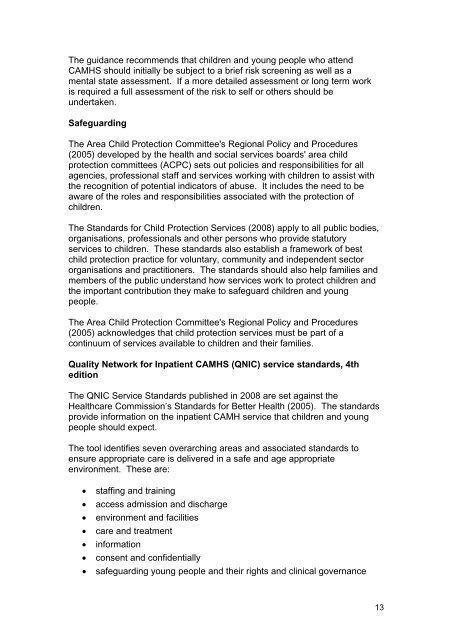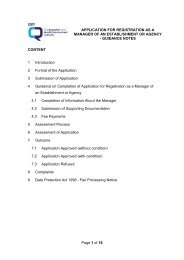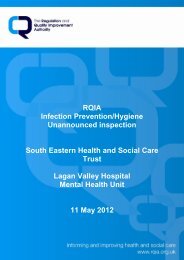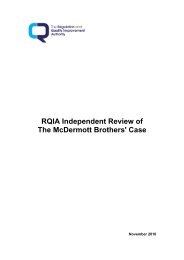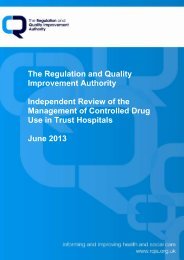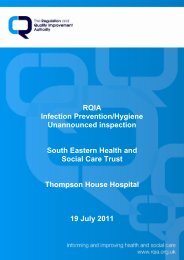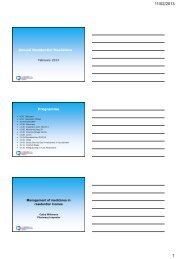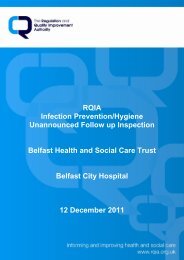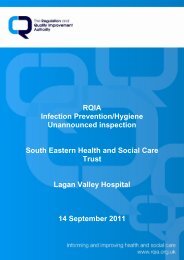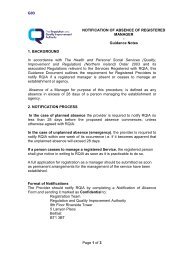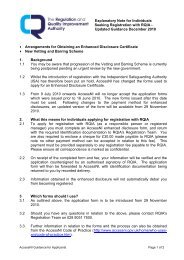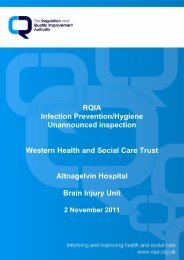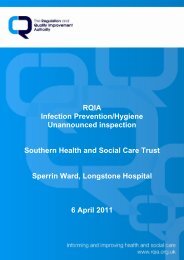RQIA Independent Review of Child and Adolescent Mental Health ...
RQIA Independent Review of Child and Adolescent Mental Health ...
RQIA Independent Review of Child and Adolescent Mental Health ...
Create successful ePaper yourself
Turn your PDF publications into a flip-book with our unique Google optimized e-Paper software.
The guidance recommends that children <strong>and</strong> young people who attend<br />
CAMHS should initially be subject to a brief risk screening as well as a<br />
mental state assessment. If a more detailed assessment or long term work<br />
is required a full assessment <strong>of</strong> the risk to self or others should be<br />
undertaken.<br />
Safeguarding<br />
The Area <strong>Child</strong> Protection Committee's Regional Policy <strong>and</strong> Procedures<br />
(2005) developed by the health <strong>and</strong> social services boards' area child<br />
protection committees (ACPC) sets out policies <strong>and</strong> responsibilities for all<br />
agencies, pr<strong>of</strong>essional staff <strong>and</strong> services working with children to assist with<br />
the recognition <strong>of</strong> potential indicators <strong>of</strong> abuse. It includes the need to be<br />
aware <strong>of</strong> the roles <strong>and</strong> responsibilities associated with the protection <strong>of</strong><br />
children.<br />
The St<strong>and</strong>ards for <strong>Child</strong> Protection Services (2008) apply to all public bodies,<br />
organisations, pr<strong>of</strong>essionals <strong>and</strong> other persons who provide statutory<br />
services to children. These st<strong>and</strong>ards also establish a framework <strong>of</strong> best<br />
child protection practice for voluntary, community <strong>and</strong> independent sector<br />
organisations <strong>and</strong> practitioners. The st<strong>and</strong>ards should also help families <strong>and</strong><br />
members <strong>of</strong> the public underst<strong>and</strong> how services work to protect children <strong>and</strong><br />
the important contribution they make to safeguard children <strong>and</strong> young<br />
people.<br />
The Area <strong>Child</strong> Protection Committee's Regional Policy <strong>and</strong> Procedures<br />
(2005) acknowledges that child protection services must be part <strong>of</strong> a<br />
continuum <strong>of</strong> services available to children <strong>and</strong> their families.<br />
Quality Network for Inpatient CAMHS (QNIC) service st<strong>and</strong>ards, 4th<br />
edition<br />
The QNIC Service St<strong>and</strong>ards published in 2008 are set against the<br />
<strong>Health</strong>care Commission’s St<strong>and</strong>ards for Better <strong>Health</strong> (2005). The st<strong>and</strong>ards<br />
provide information on the inpatient CAMH service that children <strong>and</strong> young<br />
people should expect.<br />
The tool identifies seven overarching areas <strong>and</strong> associated st<strong>and</strong>ards to<br />
ensure appropriate care is delivered in a safe <strong>and</strong> age appropriate<br />
environment. These are:<br />
• staffing <strong>and</strong> training<br />
• access admission <strong>and</strong> discharge<br />
• environment <strong>and</strong> facilities<br />
• care <strong>and</strong> treatment<br />
• information<br />
• consent <strong>and</strong> confidentially<br />
• safeguarding young people <strong>and</strong> their rights <strong>and</strong> clinical governance<br />
13


